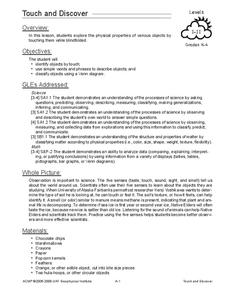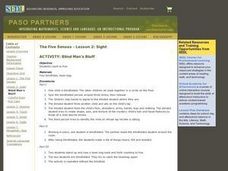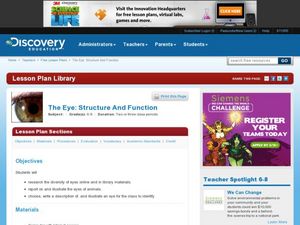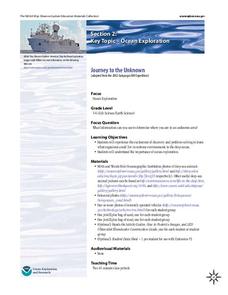Curated OER
Touch and Discover
Young scholars identify the physical properties of items using the sense of touch. In this touch and discover lesson, students describe items. Young scholars sort items using a Venn diagram.
Curated OER
Imagery: Show, Don't Tell
A vampire, the beach, a bedroom, the school cafeteria. Writers are encouraged to add sensory details (sight, touch, taste, smell, sound) to bring these things to life.
Curated OER
What Food Is It?
Students close their eyes and taste foods without using the sense of sight to identify the foods. They record what they think the food is that they tasted.
Curated OER
Special Senses
In this special senses worksheet, 9th graders briefly describe the structure of a taste bud and the pathway a signal takes to the brain. Then they list the five basic taste sensations and homeostatic values of taste. Students also...
K20 LEARN
Sweet and Savory Writing: Descriptive Writing
The engagement is in the details. Young scholars learn the benefit of weaving descriptive and sensory details into the fabric of their writing through the activities in this lesson. As their hands explore items concealed in bags, a...
University of Minnesota
Attention and Sensory Processing
Ever wondered how your brain manages all of the information it receives every second of every day? The sights, the sounds, the smells ... each one filed away for later use or moved to the front of the line so your body can react. Through...
ARKive
Nocturnal Animals
How do those nocturnal animals see in the dark? This perplexing question does have an answer. First, little ones use their sense of touch to determine the name of a mystery object, then they listen closely to identify various animals by...
Curated OER
Blind Man's Bluff
Pupils count to five. They use two blindfolds and a bean bag. One child is blindfolded. The other children sit close together in a circle on the floor.
Spin the blindfolded person around three times, then release. The children clap...
Curated OER
Using Descriptive Language
Learners explore the technique of descriptive writing. As a class, they observe a poster and describe it using adjectives. They discuss how descriptive words can be used literally and figuratively in the world of advertising. After...
Curated OER
The Ear and Sound words
In this health instructional activity, students find the words that are associated with hearing and sounds. The answers are found at the bottom of the page.
Curated OER
Forest Ecosystem Field Trip
Students investigate the environment by participating in a class field trip. In this botany lesson plan, students attend a field trip through their local park or forest while listening to a nature guide. Students practice using their 5...
Curated OER
Would You Believe Your Eyes?
Students study the parts and functions of the human eye. They create dodecagons which are twelve-sided figures with twelve equal angles and share these with the class so that each student can begin to see how many different illusions can...
Curated OER
The Eye; Structure and Function
Middle schoolers research the structure and function of the eye. In this anatomy instructional activity, students write a report about the eye and draw an illustration. They research a particular animal's eye then present their findings...
Curated OER
You Won't Believe Your Eyes!
Students gain a basic understanding of the sense of sight. They watch a video on sight, then engage in some vocabulary games, and perform some simple experiments which focus on the basics of sight.
Curated OER
In Touch with Apples
Students read "How To Make an Apple Pie and See the World", the story of a girl who traveled the world to find the ingredients to make her apple pie. They conduct a series of interdisciplinary activities including testing their senses,...
NOAA
Journey to the Unknown
What's it like to be a deep-sea explorer? Tap into the imaginations of your fifth and sixth graders with a vivid lesson, the second part of a six-part adventure. Learners close their eyes and submerge themselves in an expedition aboard...
Curated OER
Being Alive
Young biologists use a activity to fill in the blanks of five sentences. Each one needs a word from a word band at the top of the resource. All of the sentences are about things that are alive, and how we know they are alive. The words...
Curated OER
Make Sense of Nature
Students participate in this program that heightens their awareness and curiosity of nature as well as their sense of adventure and exploring new surroundings. They identify and choose an object from nature after exploring it with other...
Curated OER
You Feel Wet!
For this reading worksheet, learners learn the sight words for texture: wet, dry, soft, smooth and prickly. Students staple together an 8 page book with an animal theme. Learners read and color. In the end of the book, students list...
Curated OER
Can You Hear the River?
In this camping beginning reader learning exercise, students cut apart, color and assemble a 12 page mini book about a camping trip. The page text is in the form of questions and answers. The sight vocabulary writing practice and...
Curated OER
Activity Plan 5-6: Bugs, Bugs, Bugs!
Students become entomologists for a day. In this life science lesson, students go on an insect hunt and investigate insects and their homes. This leads to the creation of an insect by each student. Lesson includes a take-home activity...
Curated OER
In The Dark
Students go on a "trust walk" during which one student is blindfolded and led around by his/her partner.
Curated OER
Getting Oriented
Students explore the geography, culture, and philosophy of Asia using all five senses and information about China and Japan. This lesson is detailed and may take several days of in-class activities to complete.
Curated OER
Sensory Elements in the Environment
Students verbally and visually identify visual elements found around them everyday.
Other popular searches
- Five Senses Sight
- The Five Senses "Sight"
- The Five Senses Sight
- The Five Senses "Sight
- Five Senses Sight Blindfold
- Five Senses "Sight























